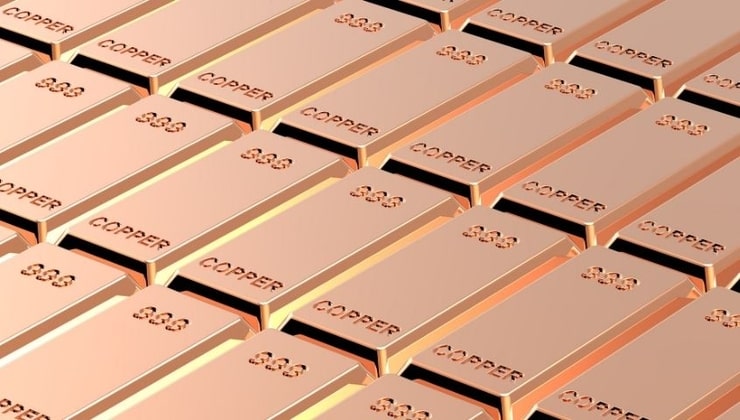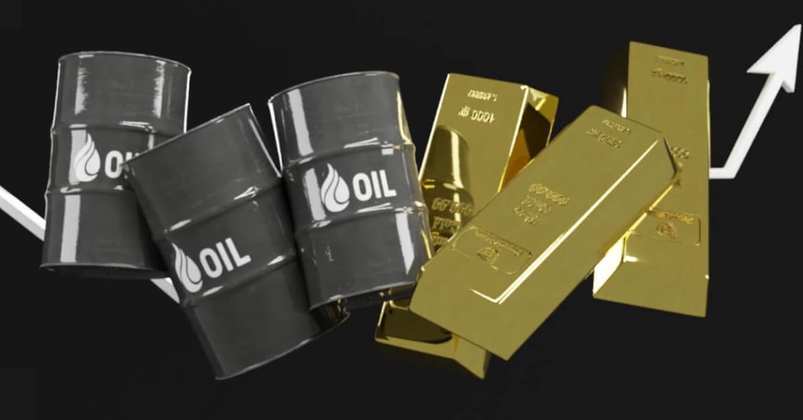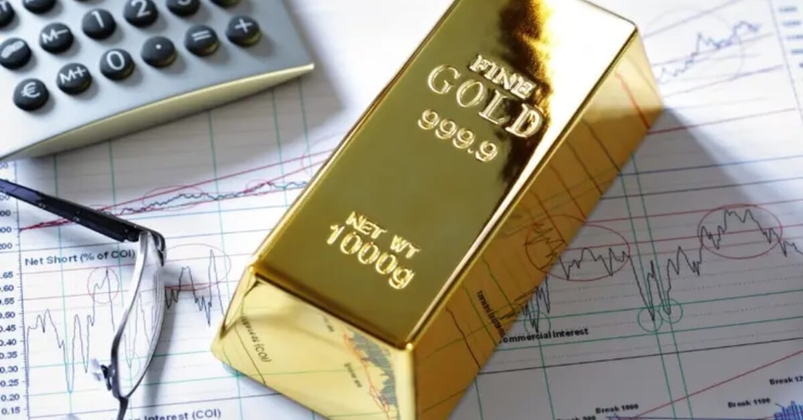Learn to trade
Five factors that will impact the copper price for the next decade

Of all the metal commodities, one of the most intriguing is copper. It's considered a bellwether for the overall macroeconomic and geopolitical stability of the markets, but it's also plugged in to many of the most exciting trends, new tech and drivers of industrial growth the world has to offer. Electric vehicles, renewable energy, decarbonisation - all require copper as a base metal. But what powers copper itself as a market?
Here, we'll break down the various drivers that are likely to affect the copper market and supply chain for the next ten years - and possibly even longer - by looking at what typically moves copper and what that means for you now.
Trade on commodities like copper Create a live Pepperstone account

A history of copper prices
In June 2023, it was believed that copper future prices would be hitting an all-time high soon, despite having plunged not too long before.1 Clearly, the copper price is a volatile one with a complex cycle. So before we get into what drives the current price of copper, let's take a look at its history.
Copper began to be traded on an exchange in 1877, when the London Metal Exchange was born. The copper price typically moved in long cycles, with higher spot and futures prices generally occurring during periods of increased demand due to industrialisation and economic growth. For example, prices bottomed out during the Great Depression, but remained relatively consistent afterwards for the majority of the 20th century.
Post-Covid in the 21st century, things have been quite different. Copper prices made the headlines when they hit $4.54 per pound on 6 May 2021. Previously, the industrial metal's record high had been an inflation-adjusted price of $4.51 per pound back in 2011. Then, a new all-time highest copper price was reached again on 6 March 2022, when copper reached $5.02 per pound.
...But why? Crucial to understanding this - and where it means current prices will go next - is a firm knowledge of the factors driving the copper price.
Factors impacting future demand for copper
There are five main drivers of the copper price:
Copper's supply - and how it balances out with demand
Exchange rates
Global economic outlook and conditions
Political instability and trading disputes
Market sentiment
1. The balance between supply and demand
The copper price is heavily influenced by the supply and demand of the commodity in various markets. Demand for copper is mainly driven by industrial activities such as manufacturing and construction, as well as investment activities. On the other hand, the supply side of copper is mainly affected by extraction levels from mines, scrap availability, and geopolitical risks. In addition to these common factors, currency exchange rates play a significant role in determining the copper price.
Historically, a main driver behind the rise in copper prices has been the increased demand from both industry and consumers due to its many uses in technology and infrastructure development. A strong global economy typically leads to higher demand for copper due to its use in various manufacturing sectors. When supply chains remain stable, this further increases demand for copper and drives up its price. Likewise a falling demand for copper usually lowers the price.
In particular, electric vehicles are currently driving up copper demand as they require four times more copper than traditional gasoline-powered cars do. Renewable energy is another driver, with wind turbines and solar panels also requiring significant amounts of copper in their construction.
Is this why copper reached such breakout highs in recent years? Well, that is only part of the story. Market reports have said that the world is facing the chance of a severe copper shortage, which could push copper to astronomical highs by the end of 2030. 2 The world seems to have come out of the pandemic, with economies reopening and requiring copper in larger amounts again, only to have been hit with a scarcity in copper not long after.
With demand unlikely to decrease materially, thanks to electric vehicles, decarbonisation and renewable energy drives worldwide, the laws of supply and demand dictate that copper prices will likely go upward and onward.
2. Currency exchange rates
One of the most essential components that determines the copper price is currency exchange rates, specifically those between the United States dollar and Chinese yuan.
The Chinese economy is the world's top consumer of copper, making up about 40 percent of total global demand. As such, any change in Chinese economic conditions can therefore have a significant impact on the global copper market. When demand for copper increases, especially in China, the price typically rises. When demand decreases, prices usually drop.
Also, the relative value of influential currencies in relation to each other can be a significant factor in determining the copper price. The US dollar, for example, tends to have an inverse relationship with copper, because it is traded in US dollars - and fluctuations in the dollar's pricing will often show up in copper's. On the other hand, a stronger dollar can lower the copper price as it makes imports more expensive.
3. Global economic outlook and conditions
The global economic outlook and conditions can have an equally significant impact on copper prices. Economists often use copper as an indicator of global economic activity, and its price is a result of the complex interaction between global supply chains and manufacturing sectors. This is so much the case, in fact, that economists and analysts sometimes refer to the precious metal as “doctor copper” for its ability to tell the financial health of a market.
Firstly, economic growth around the world can affect the price of copper due to increased production and consumption. As we've said, a strong economy will tend to increase demand for copper, while a weaker one will reduce it.
But although this may be beneficial for producers and consumers in certain markets, it could lead to an oversupply in others.
When times are bullish and economies are expanding, typically demand for copper (and subsequently the copper price) will increase. During macroeconomic uncertainty and in downturns, industrialisation and infrastructure typically take a backseat to preservation of wealth and weathering the storm. In these markets, usually prices of safe-haven assets and other precious metals like spot gold will increase, while the demand for copper will wane.
4. Political instability and trading disputes
Political instability can have a large effect on the price of copper as it can disrupt supply chains and lead to volatile market conditions.
Governments may also implement policies that could affect the market such as tariffs or import/export restrictions. These policies can cause major fluctuations in pricing depending on how they are implemented and enforced. Trade flows and trade disputes between nations can also impact the price of copper if agreements are made or broken that also affect supply.
This could be seen in the U.S.-China trade dispute in recent years, which resulted in tariffs that increased domestic costs for Chinese customers, which drove the price of copper down several times.
In addition, political instability in countries that produce or export copper, like Democratic Republic of the Congo or Chile, may spark fears of copper shortage, which can drive the copper price up. In situations where governments have imposed restrictions on the production or transportation due to conflict or civil unrest, copper prices have been known to increase dramatically.
5. Market sentiment
The most ephemeral of all copper's pricing factors is the market's outlook. Nevertheless, investor and trader sentiment, plus their outlook on the economy, can have an impact on the price of copper.
Trader sentiment is the formal term to explain how individuals and institutions feel about the overall economic environment. It can be measured through various methods, including surveys, sentiment indicators, social media analysis, and market sentiment indexes. Sentiment is most often categorised as one of three outlooks:
- bullish (positive sentiment)
- bearish (negative sentiment)
- neutral (no strong bias)
When investors and traders are bullish on the economy as a whole, the price of copper tends to appreciate. It often depreciates when economies are in turmoil, as things like tech innovation and industrialisation (both of which require copper) get put on the backburner. So much so that falling copper prices are often a lagging indicator that suggest investors are negative on the outlook for the economy.
For instance, in 2023 copper prices were largely volatile due to macroeconomic factors, fears of a global recession, a higher U.S. dollar and a mass sell-off on the London Metal Exchange.
The TL;DR Summary:
- The copper price is an interesting commodity to watch. Copper is so widely used in many technological innovations at the forefront of civilisation currently - from electric vehicles to decarbonisation and more.
- Because of its crucial role in industry and tech, copper is often seen as an indicator of the overall health of the economy. When times are good and markets are bullish, the demand (and price) of copper tends to rise.
- During 2023, there were warnings of a severe copper shortage in the near future, making copper a definite commodity to watch. But before you trade on copper, it's vital to know the key common factors that influence how it’s priced
- Because copper's biggest user worldwide is China, but copper itself is priced in US dollars, currency exchange rates can also affect the copper price.
Sources:
1 MINING.COM publication, 2023
2 MarketWatch, 2023
The material provided here has not been prepared in accordance with legal requirements designed to promote the independence of investment research and as such is considered to be a marketing communication. Whilst it is not subject to any prohibition on dealing ahead of the dissemination of investment research we will not seek to take any advantage before providing it to our clients.
Pepperstone doesn’t represent that the material provided here is accurate, current or complete, and therefore shouldn’t be relied upon as such. The information, whether from a third party or not, isn’t to be considered as a recommendation; or an offer to buy or sell; or the solicitation of an offer to buy or sell any security, financial product or instrument; or to participate in any particular trading strategy. It does not take into account readers’ financial situation or investment objectives. We advise any readers of this content to seek their own advice. Without the approval of Pepperstone, reproduction or redistribution of this information isn’t permitted.

